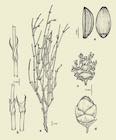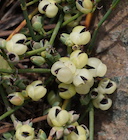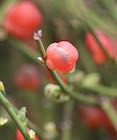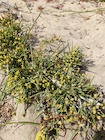
Illustration, from Martínez Carretero (2018).

A large plant in habitat, Chile; iNaturalist observation 29922585 [Vicente Pantoja, 2019.07.31].

Plant in habitat, Chile, showing the distinctive leaves; iNaturalist observation 81774927 [Carolina Fuentes, 2021.06.04].

Active pollen cones on a plant in habitat, Chile; iNaturalist observation 94490456 [Macarena Andrea Villalobos Farías, 2021.09.11].

Yellowish fruits and leaves on a plant in habitat, Chile; iNaturalist observation 73528404 [Joaquin Sepulveda, 2017.12.13].

Yellowish fruits and leaves on a plant in habitat, Chile; iNaturalist observation 23025912 [orlandomontes, 2018.11.22].

A plant in habitat, Chile, illustrating the rhizomatous habit; iNaturalist observation 62081890 [ludovica, 2020.10.03].

Ephedra chilensis
C. Presl 1843
Common names
Jointfir, pinco-pinco (or pingo-pingo).
Taxonomic notes
Synonymy:
- Ephedra bracteata Miers 1826;
- Ephedra andina Poepp. ex C.A. Mey. 1845;
- Ephedra andina Poepp. & Endl. 1847;
- Ephedra chilensis Miers 1863;
- Ephedra dumosa Miers 1863;
- Ephedra monticola Miers 1863;
- Ephedra americana var. andina (Poepp. ex C.A.Mey.) Stapf 1889; and
- Ephedra araucana Phil. 1895.
Description
Dioecious subshrubs or shrubs to 1.5 m tall. Rhizomatous. Young branches upright. Leaves (2.5-)3-9(-12) mm, decussate. Pollen cones globose or ovoid, simple or branched, sessile or pedunculate, terminal or axillary; bracts decussate, fused for up to 1/2 of their length. Pollen cones fleshy when ripe, globose, pink or red. Seeds 2, covered by the upper pair of bracts (Martínez Carretero 2018).
Martínez Carretero (2018) also gives a key to the six Argentine species of Ephedra.
Distribution and Ecology
Argentina: Mendoza, Neuquén; Chile: Maule, Valparaíso, Antofagasta, Santiago; perhaps Bolivia; at elevations of 300-3850 m in shrubland, rocky areas, and desert (Bell and Bachman 2011). The distribution is primarily in Chile.
Note that since the IUCN (assessment by Bell and Bachman 2011) treats E. gracilis as a synonym of E. chilensis, conservation assessments and range data for the two taxa are conflated. E. gracilis has a smaller distribution that falls within the Chilean range of E. chilensis.
Remarkable Specimens
No data as of 2023.03.03.
Ethnobotany
Observations
Remarks
The epithet means "of Chile".
Citations
Bell, A. and S. Bachman. 2011. Ephedra chilensis. The IUCN Red List of Threatened Species 2011. https://www.iucnredlist.org/species/201695/9167159, accessed 2021.12.27.
Huxley, A. 1992. The New RHS Dictionary of Gardening. MacMillan Press (as E. americana var. andina).
Martínez Carretero, Eduardo. 2018. Ephedraceae Dumort. in Flora de Mendoza, Multequina 27: Fascículo 10, FM 1-9. Available: https://www.redalyc.org/jatsRepo/428/42857911008/42857911008.pdf, accessed 2021.12.26.
Presl, Karl B. 1843. Botanische Bemerkungen. Abh. Königl. Böhm. Ges. Wiss., ser. 5, 3: 539. Available: Biodiversity Heritage Library, accessed 2021.12.27.
See also
Species profile at Plants of the World Online, accessed 2021.12.27.







